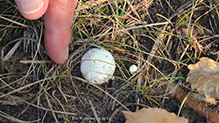Curtis’s Puffball
(Lycoperdon curtisii)
Conservation • Description • Habitat • Ecology • Distribution • Taxonomy
Conservation Status |
|
|||||||
| IUCN Red List | not listed |
|||||||
| NatureServe | NNR - Unranked |
|||||||
| Minnesota | not listed |
|||||||
Description |
||
Curtis’s Puffball is a common, small puffball. It occurs in the United States and southern Canada east of the Great Plains and west of the Rocky Mountains, with just a handful of records between. It also occurs in Mexico and Central America. It is found in late summer and fall usually in tight clusters, sometimes grouped but not clustered (gregarious). It grows on the ground in grassy areas. It obtains its nutrients from decaying organic matter (saprobic). The fruiting body looks like a ball. It is white, spherical, and ⅜″ to ¾″ (10 to 20 mm) in diameter. It may be a little larger, but it is never as big as a ping-pong ball. When clustered, the shape becomes contorted from pressure by adjacent fruiting bodies. When young, it is densely covered with white, curved spines. The surface (peridium) between the spines is covered with powdery granules. The spines are 1⁄32″ to 1⁄16″ (1 to 2 mm) long and are fused at the tips with other spines creating a pyramid or star shape. The spines easily rub off. As it ages, the peridium turns light brown and the spines fall away in small groups, not in sheets. When mature, a pore-like mouth develops at the top (apex) through which spores are released by wind and rain. The puffball appears pinched at the bottom but there is no stalk. It is attached at the base to white filaments (rhizoids). The spore mass (gleba) is white and firm when young, becoming yellowish to olive and granular as it ages, finally brownish or purplish-brown and powdery when mature. It is edible when it is young and the flesh is firm and white, but it is too small to be worth collecting. |
||
Similar Species |
||
Habitat and Hosts |
||
Grassy areas |
||
Ecology |
||
Season |
||
Late summer and fall |
||
Distribution |
||||
|
Sources |
|||
| 10/12/2023 | ||||
Occurrence |
||||
Common |
||||
Taxonomy |
|||
| Kingdom | Fungi (Fungi) | ||
| Subkingdom | Dikarya | ||
| Phylum | Basidiomycota (Basidiomycete Fungi) | ||
| Subphylum | Agaricomycotina (Higher Basidiomycetes) | ||
| Class | Agaricomycetes (Mushrooms, Bracket Fungi, Puffballs, and Allies) | ||
| Subclass | Agaricomycetidae | ||
| Order | Agaricales (Common Gilled Mushrooms and Allies) | ||
| Suborder | Suborder Agaricineae | ||
| Family | Lycoperdaceae (puffballs) | ||
| Genus | Lycoperdon | ||
Order Family Genus |
|||
Synonyms |
|||
Vascellum curtisii |
|||
Common Names |
|||
Curtis’s Puffball |
|||
Glossary
Gleba
The inner spore-bearing mass of puffballs, earthstars, and stinkhorns. The term is also used to refer to the spore-bearing slime covering the head of a stinkhorn.
Rhizoid
A filament arising from the lower stem of a moss, liverwort, or alga that anchors it to a substrate.
Saprobic
A term often used for saprotrophic fungi. Referring to fungi that obtain their nutrients from decayed organic matter.
Visitor Photos |
|||||
Share your photo of this fungus. |
|||||
| This button not working for you? Simply email us at info@MinnesotaSeasons.com. Attach one or more photos and, if you like, a caption. |
|||||
Dan W. Andree |
|||||
Small & Tiny White Puffballs... I came across these two today out at Frenchman’s Bluff SNA. I think they are baby Puffballs of some sort. |
|||||
 |
 |
||||
MinnesotaSeasons.com Photos |
|||||
|
|||||

Slideshows |
||

Visitor Videos |
|||
Share your video of this fungus. |
|||
| This button not working for you? Simply email us at info@MinnesotaSeasons.com. Attach a video, a YouTube link, or a cloud storage link. |
|||
Other Videos |
|||


Created: 10/12/2023
Last Updated:

